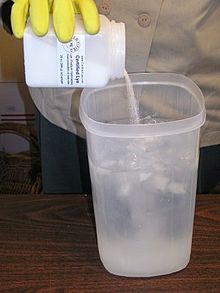Sodium Hydroxide Soap Making
Also known as lye, NaOH, or caustic soda, and a must-have for making soap
Lye or sodium hydroxide for soap making (or NaOH), is needed for cold-process soap, and making cold-process soap is what this website is about.
 Lye is also known as caustic soda, it is a caustic metallic base.
Lye is also known as caustic soda, it is a caustic metallic base.
Lye or sodium hydroxide for soap-making creates a strong alkaline solution when dissolved in water.
It is used in many industries as a strong chemical base in the manufacture of pulp and paper, textiles, drinking water, soaps and detergents, anti-wrinkle face cream, and drain cleaners.
Yes, that’s right drinking water and anti-wrinkle cream…..those two got me.
Well in drinking water sodium hydroxide is used to treat the water if it is acidic. The Sodium hydroxide helps to raise the PH. It’s usually injected into the water with corrosion-resistant chemical feed pumps.
Sodium Hydroxide is used in face creams to balance the PH and also used as a buffer, my understanding is that some companies add a small amount of it as an anti-wrinkle agent, which creates a very minor burn action on your face, which in return, your skin adds fluid to the area in order to protect itself, and thus, the “appearance” of younger looking skin. So be sure to check the labels of those expensive creams.
Well, back to soap and lye. After the soap has been made and cut into bars, it should sit to cure for 4 – 6 weeks. When it is finished curing there is no trace of lye left.
Because Sodium Hydroxide is a common base in chemical labs, 45 million tonnes plus are produced each year.
Basically, lye is an electrolyzed salt, pure sodium hydroxide is considered solid; and is available in pellets, flakes, and granules. I buy granules in 50 lb bags for my soap making. Lye is hygroscopic, it absorbs water from the air, so it should be kept in air-tight containers.
You may also want to read What to do if you get Lye on your skin?
Sodium Hydroxide (Lye) for soap making
#handmadesoap #naturalsoap #makingsoapnaturally #soapmaking #soapmaking #soaps #artisansoap #bathandbody #cpsoap #coldprocesssoap #etsy #soapbase #soapcrafter #soapmaker #soaping #soapcrafting #soaphandmade #soap #giftidea #christmas #barsoap #handmadesoap #natural #organic #skincare #coldprocess #soapsupplies #lye #sodiumhydroxide
© 2016 – 2023, Tes. All rights reserved.

I have irritated skin after using my cured soap. If I leave my soap to cure longer will it help the soap to not irritate.
Hi Janine,
If the soap has not been properly cured that can certainly be a cause, or your soap could be lye heavy (to much lye) Your homemade Soap should be cured for a minimum of one month, but you could also be having an allergic reaction to one of the oils you are using. You could also check the PH of you soap, making sure it is not to high. Test the PH of you soap